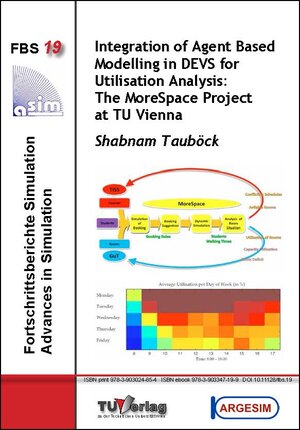
×
![Buchcover ISBN 9783903024854]()
Integration of Agent Based Modelling in DEVS for Utilisation Analysis: The MoreSpace Project at TU Vienna
In this dissertation an approach to integrating agent based modelling into a discrete
event simulation system is developed and tested in the course of the MoreSpace
project done at the Vienna University of Technology. Considering the basic
formalism of DEVS a Discrete Event System Specification (DEVS) is a structure 𝑀 =
(𝑋, 𝑆, 𝑌, 𝛿𝑖𝑛𝑡 , 𝛿𝑒𝑥𝑡 , 𝛿𝑐𝑜𝑛 , 𝜆, 𝑡𝑎), where X is the set of input values, S the set of states, Y the
set of output values, 𝛿𝑖𝑛𝑡 the internal transition function, 𝛿𝑒𝑥𝑡 the external transition
function, 𝛿𝑐𝑜𝑛 the confluent transition function, 𝜆 the output function, 𝑡𝑎 the time
advance function. Several of this so called atomic models can be put together to form
a coupled model.
An agent based model is defined as tuple 𝐴, 𝐸 where A is a set of agents with
𝐴 = ⋃𝑎𝑘and 1 ≤ 𝑘 ≤ 𝑁𝑎𝑔𝑒𝑛𝑡𝑠 and E is the Environment. The agent k itself is defined
as a function 𝑎𝑘 : 𝑅𝑆
𝑘 → Λ𝑘 ; an Environment E is defined as tuple Σ, 𝜏 where Σ is the
system state, 𝜏: 𝑅Λ → Σ is a state transformer function that changes the system state
based on 𝑟𝑖
𝑘 ∈ 𝑅Λ with
𝑠𝑗
𝑘 is the 𝑗𝑡set of state variables that is seen by agent k where 1 ≤ 𝑘 ≤
𝑁𝑎𝑔𝑒𝑛𝑡 𝑠
𝛼𝑗
𝑘 is the 𝑗𝑡action done by agent k in response to a set of state variables 𝑠𝑗
𝑘
𝛬𝑘 = ⋃𝛼𝑗
𝑘all actions done by agent k
𝑟𝑖
𝑘 , the 𝑖𝑡 run of agent 𝑎𝑘 , is the 𝑖𝑡 sequence of interleaved 𝑠0
𝑘 , 𝛼0
𝑘 , 𝑠1
𝑘 , 𝛼1
𝑘 , …
𝑅𝑘 = ⋃𝑟𝑖
𝑘 , the set of runs of agent k, where 1 ≤ 𝑖 ≤ 𝑁𝑟𝑢𝑛𝑠
𝑘
𝑅𝑆
𝑘 = 𝑅𝑘 that ends with an 𝑠𝑗
𝑘
During the last years the feasibility of finding an equivalent discrete event model for
any agent based model that conforms to the specification given above has been
discussed and shown in several publications. This implies that every agent that is
part of such an agent based system can be integrated in a discrete event system. It is
obvious that both modelling techniques have their advantages and drawbacks.
Discrete Event Simulation is known to be efficient and fast as long as the concept of
event driven time steps is able to use its advantage of jumping over time intervals
where no changes to the system state occur and only update the system elements of
the time points where events are schedules or triggered. People‟s behaviour and
movement is hard to model in such a system. Movement i. e. is usually not along a
certain foretold line – people do tend to take the shortest route from A to B but the
easiest way that seems to be free of obstacles and decisions between different ways. . .
event simulation system is developed and tested in the course of the MoreSpace
project done at the Vienna University of Technology. Considering the basic
formalism of DEVS a Discrete Event System Specification (DEVS) is a structure 𝑀 =
(𝑋, 𝑆, 𝑌, 𝛿𝑖𝑛𝑡 , 𝛿𝑒𝑥𝑡 , 𝛿𝑐𝑜𝑛 , 𝜆, 𝑡𝑎), where X is the set of input values, S the set of states, Y the
set of output values, 𝛿𝑖𝑛𝑡 the internal transition function, 𝛿𝑒𝑥𝑡 the external transition
function, 𝛿𝑐𝑜𝑛 the confluent transition function, 𝜆 the output function, 𝑡𝑎 the time
advance function. Several of this so called atomic models can be put together to form
a coupled model.
An agent based model is defined as tuple 𝐴, 𝐸 where A is a set of agents with
𝐴 = ⋃𝑎𝑘and 1 ≤ 𝑘 ≤ 𝑁𝑎𝑔𝑒𝑛𝑡𝑠 and E is the Environment. The agent k itself is defined
as a function 𝑎𝑘 : 𝑅𝑆
𝑘 → Λ𝑘 ; an Environment E is defined as tuple Σ, 𝜏 where Σ is the
system state, 𝜏: 𝑅Λ → Σ is a state transformer function that changes the system state
based on 𝑟𝑖
𝑘 ∈ 𝑅Λ with
𝑠𝑗
𝑘 is the 𝑗𝑡set of state variables that is seen by agent k where 1 ≤ 𝑘 ≤
𝑁𝑎𝑔𝑒𝑛𝑡 𝑠
𝛼𝑗
𝑘 is the 𝑗𝑡action done by agent k in response to a set of state variables 𝑠𝑗
𝑘
𝛬𝑘 = ⋃𝛼𝑗
𝑘all actions done by agent k
𝑟𝑖
𝑘 , the 𝑖𝑡 run of agent 𝑎𝑘 , is the 𝑖𝑡 sequence of interleaved 𝑠0
𝑘 , 𝛼0
𝑘 , 𝑠1
𝑘 , 𝛼1
𝑘 , …
𝑅𝑘 = ⋃𝑟𝑖
𝑘 , the set of runs of agent k, where 1 ≤ 𝑖 ≤ 𝑁𝑟𝑢𝑛𝑠
𝑘
𝑅𝑆
𝑘 = 𝑅𝑘 that ends with an 𝑠𝑗
𝑘
During the last years the feasibility of finding an equivalent discrete event model for
any agent based model that conforms to the specification given above has been
discussed and shown in several publications. This implies that every agent that is
part of such an agent based system can be integrated in a discrete event system. It is
obvious that both modelling techniques have their advantages and drawbacks.
Discrete Event Simulation is known to be efficient and fast as long as the concept of
event driven time steps is able to use its advantage of jumping over time intervals
where no changes to the system state occur and only update the system elements of
the time points where events are schedules or triggered. People‟s behaviour and
movement is hard to model in such a system. Movement i. e. is usually not along a
certain foretold line – people do tend to take the shortest route from A to B but the
easiest way that seems to be free of obstacles and decisions between different ways. . .


